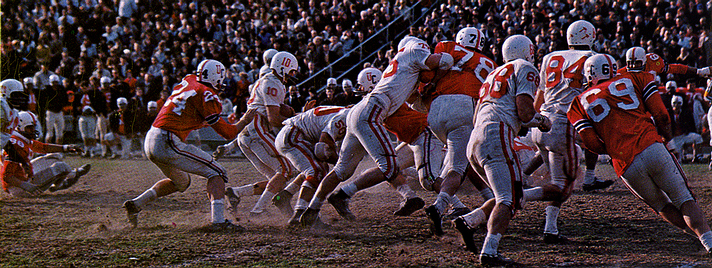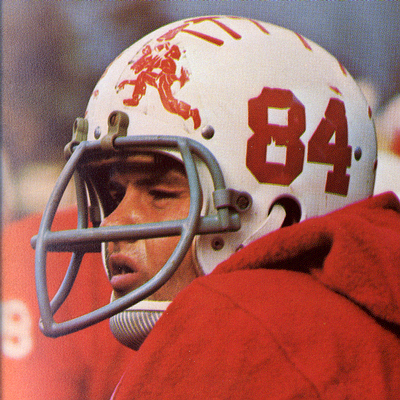

"MIAMI UNIVERSITY"
HELMET REFLECTIONS; MIAMI UNIVERSITY:
By Dr. Ken
There is “The U”, a school I didn’t like when one of their assistant coaches told me that I was too small to play for them. Though his evaluation was legitimate and accurate despite the fact that their early and mid-sixties football program was no powerhouse, the ill will remained and was given a considerable boost when brash displays of what I considered to be unsportsmanlike behavior became their norm. This of course would refer to the University Of Miami, a Florida based school of higher learning located in Coral Gables. Despite the seasonal records of the past twenty-three years the “real” Miami University is not in Florida, it is in Oxford, Ohio. When one considers the rich history of football, the number of collegiate and professional coaches that either played or coached there, and the game’s innovations that were initiated or refined on their practice fields, they are much more than their moniker as “The Cradle Of Coaches”; it is in fact The Cradle Of Football! Ohio does not have a city by the name of “Miami” nor is there a “Miami Of Ohio” and to true, die-hard football fans who know their history, there is but one Miami University or Miami in Oxford, Ohio. I learned this distinction by the third week I was in Cincinnati because Miami was our football rival in a feud that went back to 1888. It was new to me but especially in the sixties, Miami was the place to study, learn, and play football and they could compete with most of the Big Ten schools on a yearly basis. As a young football player seeking to identify with my new college and develop a sense of pride in my endeavor, I quickly learned to love Cincinnati and dislike Miami. As a fan of football history, even as a youngster, I was enamored with the entire concept of being close to and knowing I would be playing the college that could be said to have had the greatest influence on college and perhaps even high school football in the entire Midwest.
 |
Our opening game as freshmen was against the Redskins of Miami. While Greg Cook was a stud athlete from Chillicothe, Ohio and later the 1969 American Football League Rookie Of The Year with what Bill Walsh called the potential and tools to be the greatest quarterback of all time if he hadn’t suffered severe injury, our starting quarterback was Dick Giles out of South Carolina. He threw so hard he would hurt you when you caught his passes but against Miami, his UC career was sidetracked before it began as he fumbled or dropped the ball four or five times. When Cook took over, he just never left the starter’s spot until he graduated with all of his All American accolades. I had plenty of time to muse upon the deteriorating offensive play during the game from my perch at the far end of the bench and what I noticed most was that Miami was a beautiful school, a wonderful looking campus where their fans even clapped for us as we walked from the bus to the locker room and then onto the field. If one can instinctively know that they should have attended school elsewhere, this was it for me.
 |
Miami Head Coach Schembechler was one in a long and continuing line of the most influential coaches of the game. Stu Holcomb (later at Purdue) was followed by the legendary Sid Gillman. Gillman’s players included Parseghian, Pont, Dietzel, and others. George Blackburn came next but he bolted to Cincinnati to join Gillman at UC with a good part of the Miami team that had followed Sid there. Woody Hayes came next, left for Ohio State and Ara Parseghian took over before leaving for Northwestern and then Notre Dame. After Ara it was John Pont, the first Miami player to have his number retired and he later left for Yale and then Indiana, and Northwestern. Bo took the head job in 1963 and departed for Michigan in 1969, leaving Bill Mallory in charge. Mallory left for Colorado and then gave Indiana its best run of bowl game appearances and wins. Dick Crum then was the boss until leaving for North Carolina in 1978. Tom Reed, Tim Rose, and then Randy Walker, all head coaches elsewhere, all winners, came next until Terry Hoeppner came in, did great, developed Ben Rothelisberger, and jumped to Indiana. It just doesn’t stop and this doesn’t include the college and even numerous NFL coaches like Weeb Ewbank, John McVay and Ed Biles who played at and/or were assistants at Miami. The list of successful coaches runs into the hundreds of names and its incredible. Bo’s teams were solid right from the start and the 7-3 1965 team started slowly but finished like a house on fire. Tom Matte was better known as the running back who could fill in at quarterback for the Baltimore Colts and of course, as a star at Ohio State but younger brother Bruce was the Miami QB and a stud runner and passer. They had big, strong backs in FB Joe Kozar, a 210-pound tank and a fast All Conference HB in Al Moore who also returned their kicks. Ed Philpott, later a solid five year player with the Patriots, was a 240 pound DE and also All MAC. Two future coaches, HB Tom Reed (Miami 1978-82) and DE Joe Novak (Northern Illinois 1996 to the present) were also standout players. The following year, future Chargers and Browns LB Bob Babich was added to the mix, making the Redskins even more formidable as their conference championship 9-1 record indicated.
 |
The Miami uniforms were very cool and simple and included a unique helmet design that had the silhouette of a running Indian on each side of the front of the helmet, something rarely seen then or now, very noticeable red figures on their white shell. I thought “Now there is something very different” and the Indian figure stood out well when highlighted by the red player numerals placed on each side of the helmet, and their red jersey with white numbers. The Redskins had made a simple uniform rather unique and innovative with the placement of their school logo on the helmet. Needless to say, the Cincinnati and Miami games were always spirited and hard-nosed affairs with almost all of the Miami athletes in that time period coming from Ohio high schools, many from the nearby Cincinnati area so that there was great familiarity among the players. Although I was a “foreigner” among them, I quickly embraced the rivalry tradition and although we suffered three consecutive defeats to them, came to respect and like the way they played, and influenced the college game.